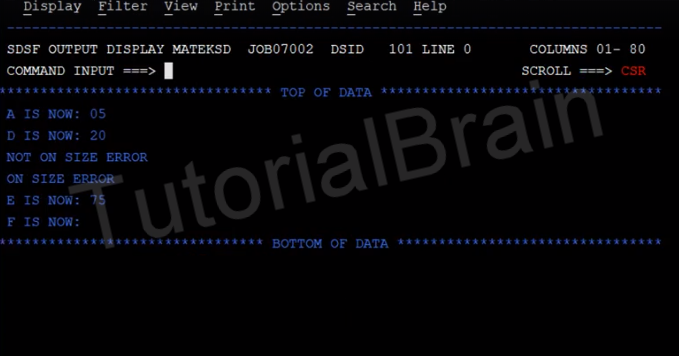In COBOL, Arithmetic operations are performed in PROCEDURE DIVISION. Arithmetic operations are performed using these major verbs-
1. ADD
2. SUBTRACT
3. MULTIPLY
4. DIVIDE
5. COMPUTE
ADD
It is used to perform an addition of 2 or more numeric literals or 2 or more numeric variables.
Syntax
ADD {CORRESPONDING/CORR} {Identifier1/literal1} TO {identifier2}
GIVING {Identifier3} {ROUNDED}
[ON SIZE ERROR imperative-statement-1]
[NOT ON SIZE ERROR imperative-statement-2]END-ADD
Most used ADD -
Format/Example 1
ADD A TO B.
Here, B = A + B
If A -> 10, B -> 20
then, B becomes 30
Format/Example 2
ADD A TO B GIVING C.
Here, C = A + B
If A -> 10, B -> 20
then, C becomes 30
Format/Example 3
ADD A TO B GIVING C D.
Here,
C = A + B
D = A + B
If A -> 10, B -> 20
then, C becomes 30
D becomes 30
Format/Example 4
ADD A TO B ROUNDED.
A PIC 99V99
IF A has a value of 90.00
B PIC 99V99
IF B has a value of 10.06
C PIC 999V9
then, C should have A + B = 100.06
but C is PIC 99V9 hence it contains a value of 100.1
Here, .06 > .05 hence it is rounded to the next higher number which is .1
Consider if the value of C after addition could be 100.04, then C = 100.0
as it is rounded to next lower number as, .04 < .05
Format/Example 5
ADD A TO B ROUNDED
ON SIZE ERROR
DISPLAY “ON SIZE ERROR”.
suppose, A – PIC 9(2) – 50
B – PIC 9(2) – 60
C – PIC 9(2)
The Output of ADD Operation :
ON SIZE ERROR
ON SIZE ERROR is displayed as C = 110 but C can hold only 2 bytes maximum
Format/Example 6
ADD A TO B ROUNDED
NOT ON SIZE ERROR
DISPLAY “NOT ON SIZE ERROR”.
suppose, A – PIC 9(2) – 50
B – PIC 9(2) – 20
C – PIC 9(2)
The Output of ADD Operation :
NOT ON SIZE ERROR
NOT ON SIZE ERROR is displayed because, C = 70 and it is within the range of values
which it can hold
Sample COBOL Program to show ADD Operation
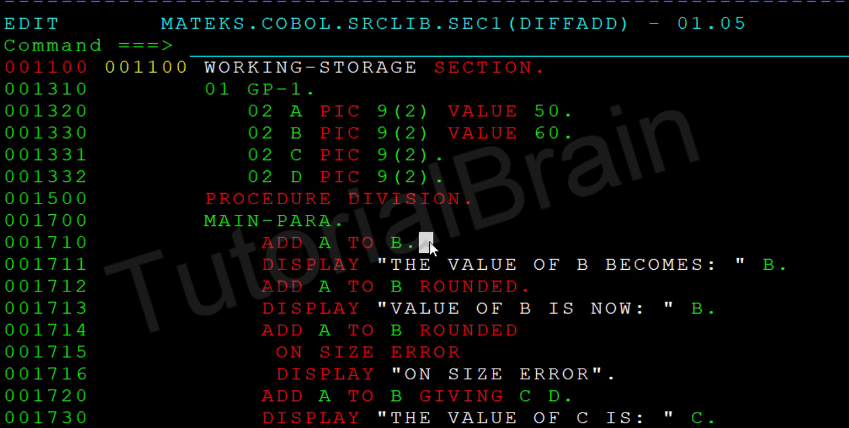
Output

SUBTRACT
It performs the below tasks
- This statement is used to perform subtraction of 2 or more numeric literals.
- SUBTRACT verb is used to subtract 2 or more numeric variables.
Syntax
SUBTRACT {CORRESPONDING/CORR} {Identifier1/literal1} FROM {identifier2}
GIVING {Identifier3} {ROUNDED}
[ON SIZE ERROR imperative-statement-1]
[NOT ON SIZE ERROR imperative-statement-2]END-SUBTRACT
Most used SUBTRACT -
Format/Example 1
A FROM B.
Here, B = B – A
If, A -> 10 and B -> 30
then, B = 20
Format/Example 2
A B FROM C D
Here, C = C-(A+B)
D = D-(A+B)
If, A -> 10, B -> 30, C -> 50 and D -> 70
then, C = 50 -(10+30) = 10
D = 70 -(10+30) = 30
Format/Example 3
A FROM B GIVING C
Here, C = B – A
If, A -> 10 and B -> 30
then, C = 20
Format/Example 4
A FROM B ROUNDED
ON SIZE ERROR
DISPLAY “ON SIZE ERROR”.
Format/Example 5
A FROM B ROUNDED
NOT ON SIZE ERROR
DISPLAY “NOT ON SIZE ERROR”.
Format/Example 6
CORRESPONDING A FROM B.
Here, The elementary subitems from group A are subtracted from group B. The values of Sub items in group A is not changed.
Sample COBOL Program to show SUBTRACT Operation
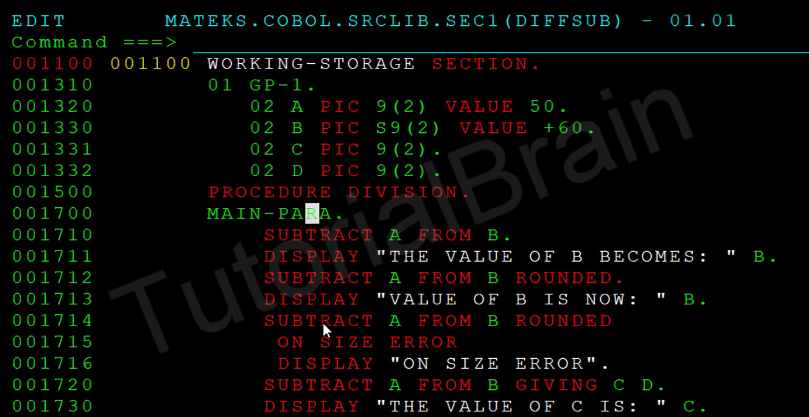

Output

MULTIPLY
MULTIPLY performs the below tasks
- This operation is used to perform multiplication of 2 numeric literals.
- MULTIPLY verb is used to multiply 2 numeric variables
Syntax
MULTIPLY {Identifier1/literal1} BY {identifier2}
GIVING {Identifier3}
[{ON SIZE ERROR/NOT ON SIZE ERROR} {imperative-statement}]
Most used MULTIPLY -
Format/Example 1
A BY B.
Here, B = A * B
Format/Example 2
A BY B GIVING C.
Here, C = A * B
Format/Example 3
A BY B GIVING C D.
Here, C = A * B
D = A * B
Sample COBOL Program to show MULTIPLY Operation
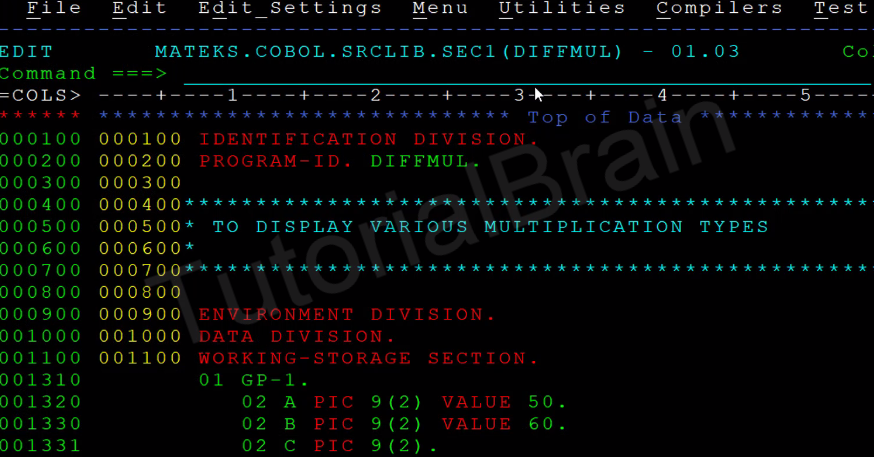



Output
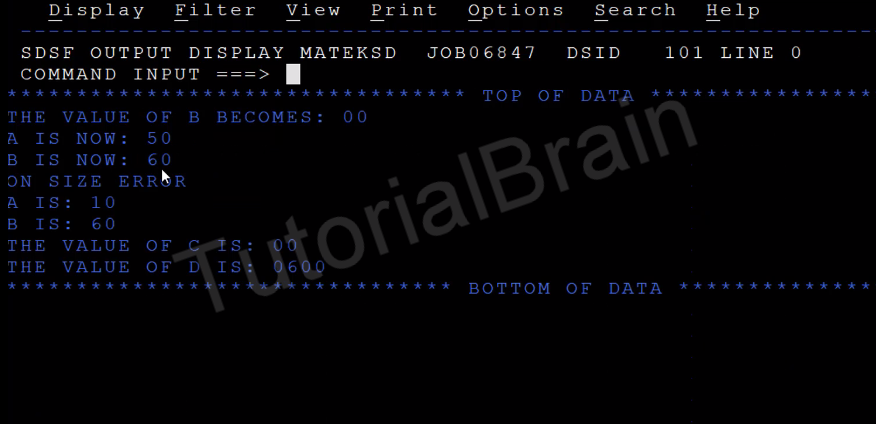
DIVIDE
DIVIDE performs the below tasks
- This operation is used to perform division of 2 numeric literals.
- DIVIDE verb is used to divide 2 numeric variables.
- Suppose NUM1 is divided by NUM2 and there is a possibility that NUM2 can take a value of ZERO. We must handle this condition as well.
Syntax
DIVIDE {Identifier1/literal1} {INTO/BY} {identifier2}
GIVING {Identifier3}
[REMAINDER identifier4][{ON SIZE ERROR/NOT ON SIZE ERROR} {imperative-statement}]
Most used DIVIDE -
Format/Example 1
A INTO B.
Here, B = B/A
DIVIDE A BY B. ==================>>>>>wrong<<<<<<<<
Format/Example 2
A INTO B GIVING C.
Here, C = B/A
Format/Example 3
A BY B GIVING C.
Here, C = A/B
Format/Example 4
A INTO B GIVING C D.
Here, C = B/A
D = B/A
Format/Example 5
A BY B GIVING C D.
Here, C = A/B
D = A/B
Format/Example 6
A BY B GIVING C REMAINDER D.
Here, C = A/B
D = Remainder
Example: If, A = 106, B = 20
C = 106/20 = 5
D = 6
Format/Example 7
A INTO B GIVING C REMAINDER D.
Here, C = B/A
D = Remainder
Example: If, A = 12, B = 105
C = 105/12 = 8
D = 9
Format/Example 8
A BY B GIVING C REMAINDER D
ON SIZE ERROR
MOVE 1 TO B.
Here, C = A/B
D = Remainder
Example:
If A = 106 and B = 0
C = 106/0 ===> Anything which is divided by zero is not defined
D = not defined.
New Value of B = 1
Sample COBOL Program to show DIVIDE Operation
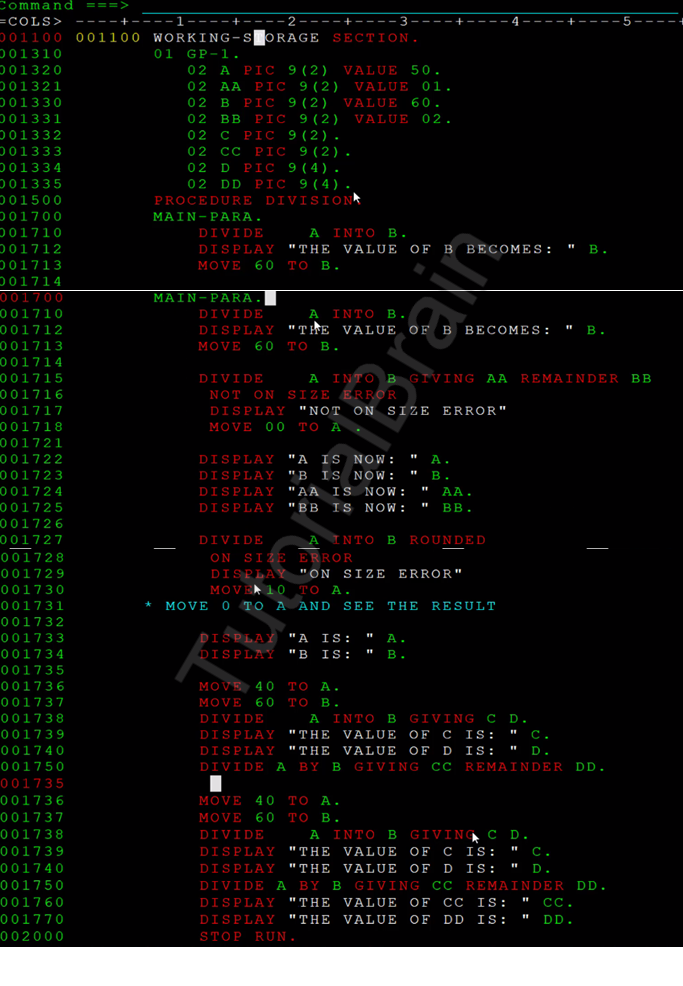
Output
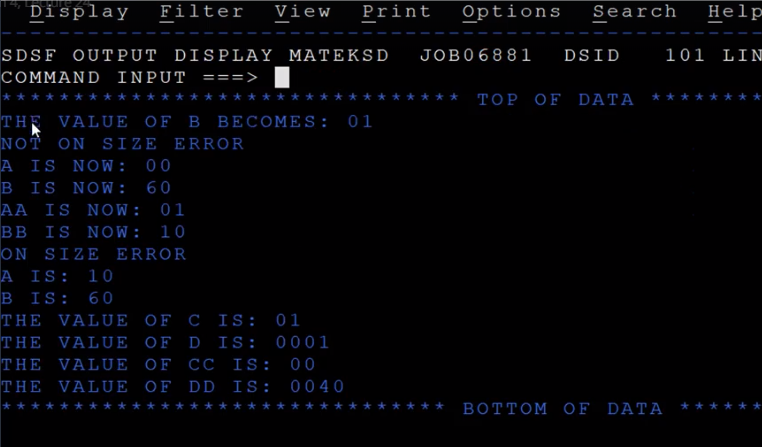
COMPUTE
It is used to assign the value of the arithmetic operations which happens at the right side of ‘=’ to the variable which is present at the left side of the ‘=’.
COMPUTE can combine all the arithmetic operation and assign the result to a variable.
EQUAL Keyword is not supported in most of the COBOL versions, always use ‘=’ symbol for assigning the result.
Syntax
COMPUTE {Identifier1/literal1} [ROUNDED] = {Identifiers involving any arithmetic operations like +,-,*,/,**}
[{ON SIZE ERROR/NOT ON SIZE ERROR} {imperative-statement}]
Most used COMPUTE -
Format/Example 1
A = B – C.
If B = 15, C = 10
Result, A = 5
Format/Example 2
D ROUNDED = A + B.
Format/Example 3
E ROUNDED = (A *B) /(D – C)
ON SIZE ERROR
DISPLAY “ON SIZE ERROR”.
Format/Example 4
E ROUNDED = (A *B) /(D – C)
NOT ON SIZE ERROR
DISPLAY “NOT ON SIZE ERROR”.
Sample COBOL Program to show COMPUTE Operation
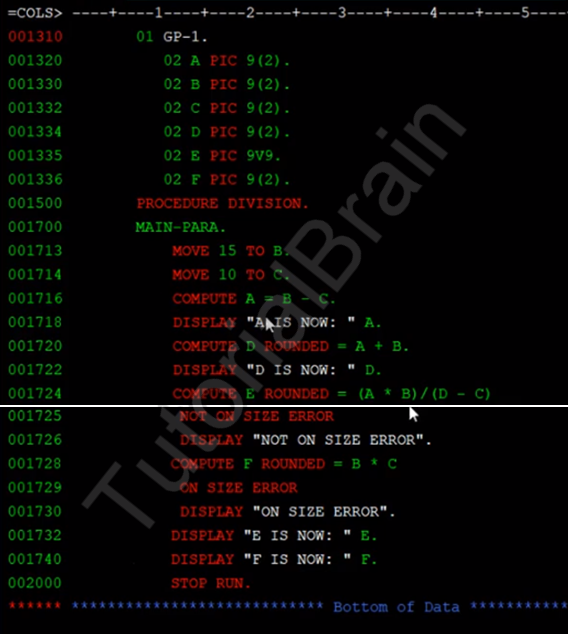
Output
